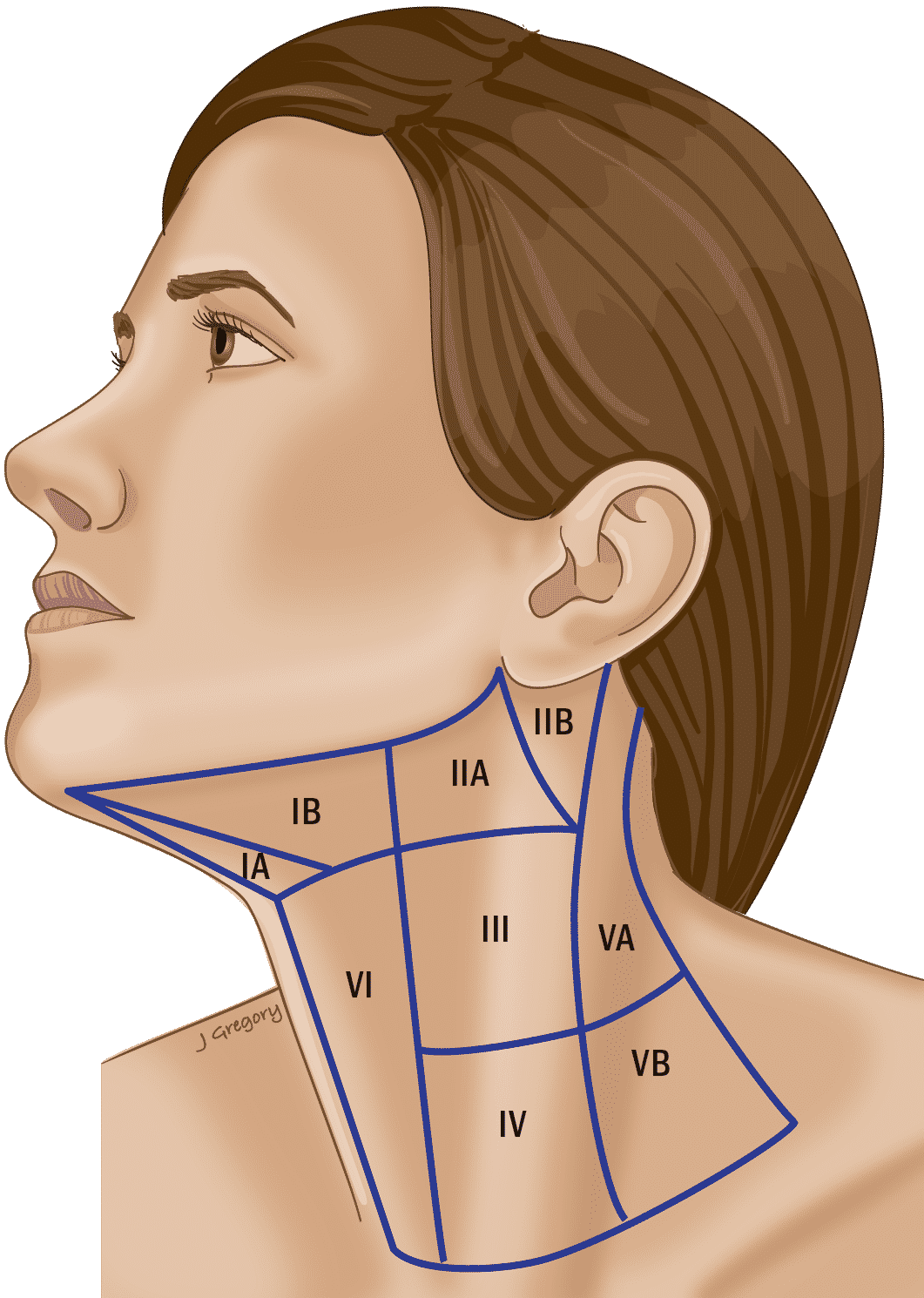A neck dissection can be done for two reasons. It can be elective, meaning that lymph nodes are removed even though there is no evidence that there is obvious cancer in the neck. An elective neck dissection will be considered if there is a high risk that there may be microscopic (occult or not clinically apparent) cancer in the lymph nodes. A neck dissection can also be therapeutic, meaning that lymph nodes are removed because there are known cancerous lymph nodes in the region, diagnosed with a biopsy or with imaging studies.
Preparing for Surgery
You will receive specific instructions from your physician for how to appropriately prepare for the procedure, such as when to arrive and food/drink restrictions. A few days before your operation, the anesthesiologist will ask you a few questions so that they can create a comprehensive anesthesia plan based on your medical history.
On the day of your surgery, you will arrive at the hospital a few hours before your scheduled procedure. The nurses, anesthesiologist, and head and neck surgery team will check in with you. If you have any last minute questions, this is a good time to ask them.
Types of Neck Dissections
Multiple approaches exist for neck dissection depending on the location and size of the primary cancer, as well as whether or not the cancer has spread to the lymph nodes.
The extent of the neck dissection will depend on a number of factors, but the most important is the site of the primary cancer. Cancers in certain locations spread to specific lymph node groups in predictable patterns. Based on these patterns, doctors can determine what type of neck dissection to perform. The general patterns include:
- Oral cavity cancers: Level I, II, III.
- Oropharyngeal, hypopharyngeal, and laryngeal cancers: Level II, III, IV.
- Scalp and facial skin cancers: Level I, II, V, and intraparotid lymph nodes.
- Thyroid cancers: Level VI, and sometimes levels II, III, and IV if positive nodes are detected.

Radical Neck Dissection
This refers to the removal of lymph nodes in groups I to V, as well as the sternocleidomastoid muscle (SCM), internal jugular vein, and spinal accessory nerve. An extended radical neck dissection includes the removal of all of these structures, plus additional lymph node groups or non-lymphatic structures not accounted for in the radical neck dissection definition. Radical neck dissections are rarely performed today as the SCM, internal jugular vein, and spinal accessory nerve can usually be preserved.
Modified Radical Neck Dissection
This is the removal of lymph nodes in groups I to V, sparing one or more of the three structures that are taken in the radical neck dissection (sternocleidomastoid muscle, internal jugular vein and spinal accessory nerve). While this is more common than a radical neck dissection, it is still less common than a selective neck dissection which is performed in most cases.
Selective Neck Dissection
This is the removal of a select group of lymph nodes in the neck, with or without the sacrifice of additional non-lymphatic structures. This is the most common type of neck dissection that is performed. Some examples of selective neck dissections are listed below:
- Supraomohyoid neck dissection: This is the removal of lymph node Groups I, II and III.
- Lateral neck dissection: This is the removal of lymph node Groups II, III and IV.
- Posterolateral neck dissection: This is the removal of lymph node Groups II, III, IV and V.
Central Compartment Lymph Node Dissection
The central compartment (Level VI) is not included in the typical “lateral” neck dissection. Level VI is most commonly removed in cases of thyroid cancer and sometimes laryngeal cancer.
Salvage Neck Dissection
This is a neck dissection that is done in patients who have received previous treatment to the neck (usually nonoperative treatments such as radiation and chemotherapy), but who have persistent or recurrent cancer remaining in the neck lymph nodes despite the previous treatment.
Removal of Skin, Carotid Artery
In some cases of very advanced tumors, the surgeon may need to remove skin as part of the neck dissection. Even more rarely, the common carotid artery (or internal carotid artery) could be involved by the tumor and require removal.

Download This Section
Feel free to download and print this page.
It’s free for personal use and to share with others you think might benefit from the information provided.
Recovery & Aftercare
When the patient first wakes up after surgery, they will likely have a drain in their neck to help remove any accumulated fluid.
The recovery course will depend on the extent of the surgery and other associated procedures. With some surgeries (such as a neck dissection alone, without any other procedures), a patient could go home after 1-2 days, while others (such as a neck dissection combined with a more complex procedure) might require a stay in the hospital for a week or more.
Once doctors determine that a patient no longer needs in-patient level care, they will be ready for discharge. While some patients can go home from the hospital with or without visiting nurses or receiving home care, others might go to a rehabilitation or skilled nursing facility for a short while before going home. The discharge planning team, which includes doctors, social workers, nurses and physical therapists, along with the patient and their family, will determine the best place for the patient to go once they’re ready to leave the hospital.

Top Questions for Your Doctor
Access our list of the most important questions to ask your physician at your next appointment.
Risks
As with any procedure, there are risks in undergoing a neck dissection.
- Bleeding (including Hematoma)
If there is severe bleeding after the procedure, the surgeon might need to quickly take the patient back to the operating room to stop the bleeding. However, some mild bleeding or small blood collections under the skin (hematomas) can be observed. - Seroma
This is a collection of normal body fluid in the neck that occurs after a surgical drain is removed. This can be treated with observation, as the body will usually resorb it, or repeated needle aspiration to drain the fluid. - Infection
With any surgical procedure, there is a risk of an infection. This might require antibiotics and/or drainage of the infection. - Nerve Damage
During surgery, it is possible that the cranial and/or cervical nerves could be damaged. These nerves are responsible for:- Shoulder shrug (CN XI, spinal accessory nerve)
- Tongue movement (CN XII, hypoglossal nerve)
- Lower lip depression (CN VII, marginal mandibular branch of the facial nerve)
- Moving the diaphragm while breathing (phrenic nerve)
- Sensation to various parts of the neck, ear and ear lobe (cervical roots and greater auricular nerve)
- Vocal cord movement and laryngeal sensation (CN X, vagus nerve)
- Arm movement (brachial plexus)
- Chyle Leak
This is a leak of fatty lymphatic fluid from one of the thoracic ducts (a tube or pathway that is part of the lymphatic system and travels from the abdomen up into the neck). The main thoracic duct is located on the left side of the neck, but there can be an additional thoracic duct located on the right side. If the surgeon identifies that there is a leak during the operation, then they will address it at that time and try to avoid a problem after surgery. However, sometimes a leak is missed or unsuccessfully repaired. A postoperative chyle leak will appear as a milky fluid coming out of the drain in a patient’s neck, likely after eating. This complication can occur after neck dissections that extend down to Level IV (just above the clavicles) because this is where the lymphatic channels that carry this fluid empty into the jugular vein. A chyle leak can usually be treated by simply changing to a non-fat diet and sometimes putting pressure over the area or starting a medication. If the problem persists, the patient may need to undergo an additional operation to clip the leaky duct. - Recurrent or Chronic Facial Swelling
This can happen in two situations: when both internal jugular veins were sacrificed during surgery, or in severe lymphedema (lymphatic obstruction caused by the removal of all the lymphatic drainage pathways). This is a rare complication of neck dissections and is usually only seen in very advanced disease, or in patients who have received previous treatments. - Blood Clots
Patients who undergo major surgeries, especially patients who have cancer, are at an increased risk of developing blood clots in their legs (deep venous thrombosis or DVT). Sometimes these blood clots can travel through the veins and into the lungs, causing a pulmonary embolism (PE). If such a problem occurs, patients will likely require anticoagulation (blood-thinning) medication to prevent more clots from forming and ending up in their lungs.











